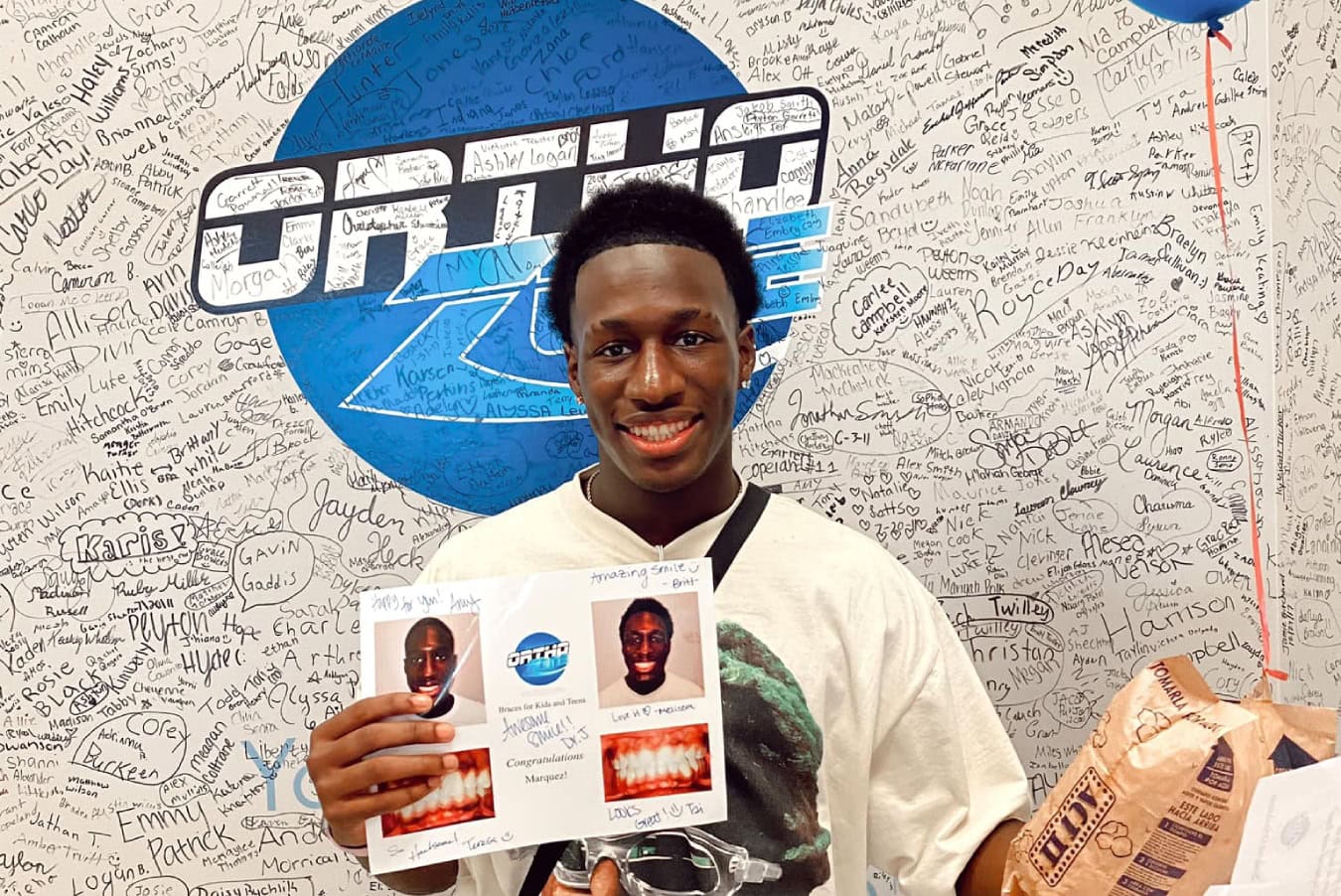Two-Phase Treatment
Two-phase orthodontic treatment is a specialized process that combines tooth straightening and physical, facial changes. The purpose of two-phase treatment is to maximize the opportunity to accomplish the ideal healthy, functional, and aesthetic result that will remain stable throughout your child’s life.
Phase 1
The goal of Phase 1 treatment is to help the jaw develop in a way that will accommodate all of the permanent teeth and improve the way the upper and lower jaws fit together. Children often exhibit early signs of jaw problems as they grow and develop. An upper jaw that is growing too much or too narrow can be recognized at an early age. If children over the age of six are found to have this jaw discrepancy, they are candidates for early orthodontic treatment. Also, if children around the age of 8 have crowded front teeth, early treatment can prevent the need to extract permanent teeth later.
Children benefit tremendously from early-phase treatment. Receiving early treatment may prevent the removal of permanent teeth later in life, or the need for surgical procedures to realign the jaws.
Orthodontic records will be necessary to determine the type of appliances to be used, the duration of treatment time, and the frequency of visits. Records consist of models of the teeth, X-rays, and photographs. During your child’s initial consultation, the doctor will take records to determine if early treatment is necessary.
Resting Period
In this phase, the remaining permanent teeth are left alone as they erupt. Retaining devices may not be recommended if they would interfere with eruption. It is best to allow the existing permanent teeth some freedom of movement. A successful first phase will have created room for permanent teeth to find an eruption path. Otherwise, they may become impacted or severely displaced.
At the end of the first phase of treatment, teeth are not in their final positions. This will be determined and accomplished in the second phase of treatment. Selective removal of certain primary (baby) teeth may be in the best interest of enhancing eruption during this resting phase. Therefore, periodic recall appointments for observation are necessary, usually on a 6-month basis.
Phase 2
The goal of the second phase is to make sure each tooth has an exact location in the mouth where it is in harmony with the lips, cheeks, tongue, and other teeth. When this equilibrium is established, the teeth will function together properly. Phase 2 usually involves full upper and lower braces.
At the beginning of the first phase, orthodontic records were made and a diagnosis and treatment plan was established. Certain types of appliances were used in the first phase to correct and realign the teeth and jaw. The second phase begins when all permanent teeth have erupted, and usually requires braces on all the teeth for an average of 24 months. Retainers are worn after this phase to ensure your child retains his or her beautiful smile.
Early Treatment
What is the difference between early orthodontic treatment and regular orthodontic treatment, and why might my child need early treatment? How will early treatment benefit my child in the long run?
These are just a few of the questions surrounding the topic of early orthodontic treatment for children. The American Association of Orthodontists recommends that children see an orthodontist as early as age 7. At this point, your orthodontist will evaluate whether your child will need orthodontic treatment.
Early treatment (also known as Phase 1) typically begins around age 8 or 9 (Phase 2 will begin around age 11 or older). The goal of early treatment is to correct the growth of the jaw and certain bite problems, such as underbite. Early treatment also helps to make room for permanent teeth to come in properly, lessening the chance of extractions in the future.

Mouthguards
Protecting your smile while playing sports is essential when you have braces. Mouthguards help protect your teeth and gums from injury. If you participate in basketball, boxing, hockey, football, gymnastics, lacrosse, martial arts, racquetball, rugby, track and field, skateboarding, skiing and snowboarding, skydiving, soccer, surfing, volleyball, water polo, weightlifting, or wrestling, it is recommended by the American Association of Orthodontists that you wear a mouthguard.
Choosing the right mouthguard is essential. There are three basic types of mouthguards: the pre-made mouthguard, the “boil-and-bite” fitted mouthguard, and a custom-made mouthguard from your orthodontist. When you choose a mouthguard, be sure to pick one that is tear-resistant, comfortable, and well-fitted for your mouth, easy to keep clean, and does not prevent you from breathing properly.
Pre-made mouthguards and boil-and-bite mouthguards can be purchased at most sporting goods stores, while custom-made mouthguards are specially designed by your orthodontist to provide optimal protection against mouth injuries. If you wear braces or a retainer, it is imperative for you to wear a mouthguard during contact sports. Your doctor can show you how to wear a mouthguard properly and how to choose the right mouthguard to protect your smile.
Taking Care of Your Mouthguard
Similar to a retainer, braces, or any other special dental appliance, it is important to take care of your mouthguard by storing it properly and keeping it clean, as well as knowing when to replace your old mouthguard with a new one. Here are a few simple ways to keep your mouthguard clean and working correctly:
- Gently scrub your mouthguard after each use with a toothbrush and toothpaste.
- Store your mouthguard in a protective case.
- Do not leave your mouthguard in the sun or in hot water, because it may melt or become deformed.
- Replace your mouthguard at the beginning of every new sports season. You should also replace your mouthguard if you notice it has become worn and no longer fits properly.
- Do not wear a retainer with your mouthguard. If you wear braces, your dentist will help design a mouthguard to protect your teeth and your braces.
- Do not chew on or cut pieces off of your mouthguard. Mouthguards come in different shapes and sizes; ask your dentist which is best for you.
- Bring your mouthguard to each dental checkup, so your dentist can check to make sure it’s still in good shape!
Sports-related injuries to the mouth and jaw are some of the most common injuries incurred by athletes. Our goal is to help minimize your chances of a sports-related injury to your smile. Be sure to ask your doctor about mouthguards at your next appointment — GO TEAM!

Retainers
After the hard work of wearing braces or Invisalign aligners, retainers play a pivotal role in maintaining the beautiful results achieved through your treatment. Our goal is to provide you with all the information you need about the types, care, and importance of retainers, ensuring that your investment in a healthier, more attractive smile lasts a lifetime.
Orthodontic treatments realign teeth into their ideal positions, but once these appliances are removed, teeth have a natural tendency to shift back toward their original positions. This is where retainers come in — they are custom-made appliances designed to hold your teeth in place during the crucial stabilization period following orthodontic treatment. By wearing a retainer as recommended by your orthodontist, you can protect your smile and the time and effort invested in achieving it.
At OrthoZone, we understand that each patient’s needs and preferences are unique, which is why we offer various types of retainers to suit different lifestyles and requirements. Whether you’re transitioning from braces or Invisalign, we’re here to guide you through the next phase of your orthodontic care with personalized advice and support.
Retainer Instructions
- Wear your retainer at all times, until the doctor instructs otherwise.
- Take your retainer out when eating, and always put it back in its case! (Most appliances are lost in school lunchrooms or restaurants.)
- Clean the retainer thoroughly once a day with a toothbrush and toothpaste. Use warm but not hot water. Brushing retainers removes the plaque, and eliminates odors. Efferdent® or other orthodontic appliance cleaners can be used but do not take the place of brushing.
- When your retainer is not in your mouth, it should ALWAYS be in its case. Pets love to chew on them!
- Initially, you may find it difficult to speak. Practice speaking, reading, or singing out loud to get used to it faster.
- Retainers are breakable, so treat yours with care. If your retainer gets lost or broken, call us immediately.
- If you have any questions or concerns about your retainer, or you believe it needs adjusting, call us. Do not try to adjust it yourself.
- Always bring your retainer to your appointments.
- Retainer replacements are expensive, but with proper care, they will last for years!
- Remove your retainer when you go swimming.
- Keep retainers away from hot water, hot car dashboards, pockets, the washing machine, and napkins.